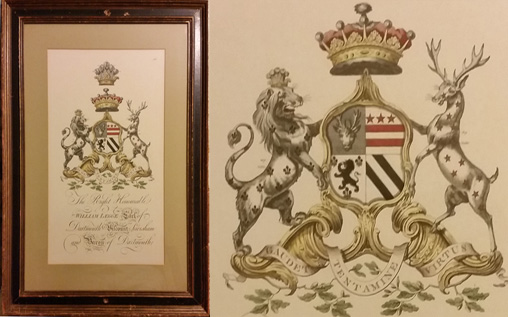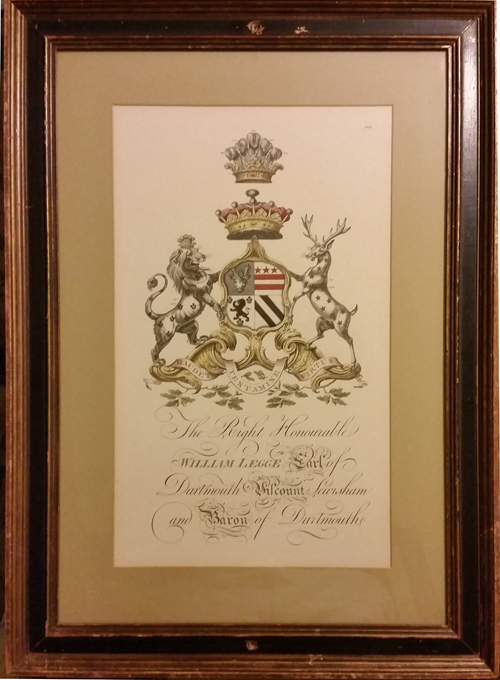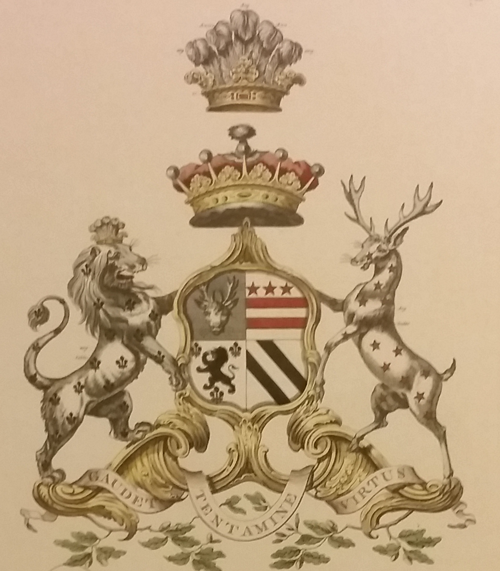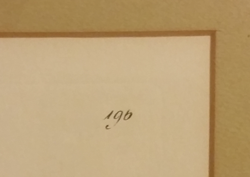William Legge, Second Earl of Dartmouth Coat of Arms (1764 – 84)


While pursuing a pile of old pictures, I happened upon a coat of arms with the family patriarch’s name written in flamboyant script: The Right Honourable William Legge, Earl of Dartmouth, Viscount Lewisham and Baron Dartmouth of Dartmouth. This is EXACTLY what my wife hates me dragging home. I was just about to walk away when it hit me the print had a heavy impression around the edges. That only occurs when an impression is made from copper prints on hand made paper circa 1650 to early 1800s. Anything before this time would be made from wood block carvings and would have really uneven handmade paper and thick lines. Anything after 1850 would most likely be a lithograph or steel plate engraving which is speckled when looked at under magnification.
Long story short, this is a 18th century copperplate engraving on hand laid paper of William Legge, Second Earl of Dartmouth’s coat of arms. The engraving is from Joseph Edmondson’s Baronagium Genealogium, or the Pedigrees of the English Peers published in London, 1764-84. That makes this engraving conservatively over 230 years old!
Here are some additional facts gleaned from various sources. I have taken the unusual step of copying the text into the page since it is from an auction site which tend to be fleeting:
Edmondson Coat of Arms William Legge Earl of Dartmouth
This 18th century heraldry copperplate engraving features the coat of arms for The Earl of Dartmouth, William Legge. On beautiful hand laid paper with a watermark, the engraving is from Joseph Edmondson’s Baronagium Genealogium, or the Pedigrees of the English Peers deduced from earliest times…, published London, 1764-84 in five magnificent folio volumes. A supplementary sixth volume was issued later.
This work is one of the most beautifully illustrated and comprehensive records left by a herald of the 18th century. Joseph Edmondson apprenticed first as a barber but soon abandoned this trade to become a coach painter. His fine artistic talent for emblazoning coats of armor on carriages soon developed for him a busy and exclusive clientele among the English nobility. This work led him to a serious study of heraldry and genealogy. In 1764, the College of Arms named him Mowbray herald extraordinary, an enviable honor.
His “Baronagium” was a task of infinite labor and more than 300 copperplate engravings were printed on the finest quality hand-made paper. Some of Europe’s finest artists were hired to engrave these coats of arms of notable personages of England, Scotland, Wales and Ireland.
This beautiful engraving has the William Legge family motto, “Gaudet Tentamine Virtus” or “Virtue Rejoices in Temptation”. The beautiful hand coloring has been added by a professional colorist and all the colors are true to the specifications for the William Legge family.
Connection to Dartmouth College
William Legge is the namesake of Dartmouth College. There is a rather funny account of how this came to be.
William Legge, the second Earl of Dartmouth, was the reluctant namesake of Dartmouth College. Like many of his countrymen, Legge became involved in Eleazar Wheelock’s plans through George Whitefield, the famous evangelical who introduced Samson Occom and Nathaniel Whitaker to Legge shortly after the pair’s February 1766 arrival in London. Legge proved critical in promoting Occom’s tour among the nobility, and took on a logistical role by helping to collect and oversee donations. Although Legge and Whitefield both felt it would be best if Wheelock were in total control of the funds raised in England, Occom eventually collected so much money that a formal trust was necessary to preserve propriety. This trust was formed in late 1766, with Legge as its president, to guarantee that Wheelock used the money appropriately. It soon proved that the Trust and Wheelock had different ideas as to what was, in fact, appropriate, but they were largely able to cooperate until 1769, when Wheelock obtained a charter for his school without informing the trust. (The trust, feeling that a charter would obviate its control over the British funds, had vehemently opposed it.) Adding insult to injury, Wheelock named the resulting institution Dartmouth—again without consulting Legge, and perhaps more to reassure the multitudes who had donated money than to honor the Earl. Legge never wrote to Wheelock again. Outside of his involvement with Wheelock, Legge had a brief political career. Although he was generally more concerned with religious and philanthropic matters, his station and connections (he was the step-brother of Frederick North, who was prime minister from 1770 to 1782) led him to take his first political post in 1765 as a member of the Board of Trade. During his tenure (1765-1767), and again while he was Secretary of State for the Colonies (1772-1775), Legge’s search for cooperative solutions proved unsuccessful during the build-up to the Revolution. His later positions were primarily ceremonial.
This account is from a The College on the Hill: A Dartmouth Chronicle edited by Ralph Nading Hill and produced by Dartmouth. It is less humorous, but it gives an interesting additional account.

That this could be accomplished by Dissenters at the very portals of [28] THE HISTORIC COLLEGE the official church seems unfathomable. Probably it could not have been done without the help of prominent Englishmen, notably William Legge, Second Earl of Dartmouth, the scion of an illustrious family. Born in 1731 he became at the age of thirty-four Lord of Trade and Plantations. Subsequently he was Secretary of State for the Colonies and finally Lord Privy Seal and Lord Steward of the Household to King George the Third. Because of his enlightened views of the Colonies and their problems he enjoyed unprecedented confidence at home and abroad at a time when relations with America were deteriorating. Whitefield called him “a Christian Lord and an UnCommon one.” A torchbearer for the Great Awakening in England, he was an admirer of Whitefield, and therefore of Occom and Wheelock. He became president of the London board of trustees for the handling of funds for Moor’s School and secured from the King a gift of £200.
